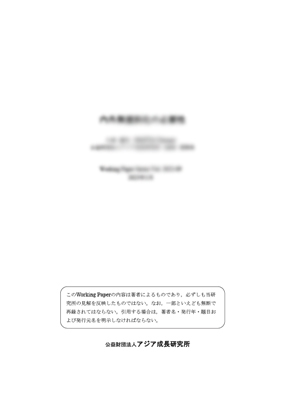Emission Trading in India: A Study of Two Schemes

| Author | Kaushik Ranjan Bandyopadhyay |
|---|---|
| Date of Publication | 2016. 1 |
| No. | 2016-03 |
| Download | 1642KB |
Contents Introduction
The paper reviews two schemes in India that have some degree of resemblance with the market based emission trading mechanism like EU-ETS. The first scheme is an innovative emission trading scheme on an air pollutant namely respiratory solid particulate matter (RSPM) with serious potential health implication. The scheme has been piloted in industrial clusters of three polluting states in India (Gujarat, Maharashtra and Tamilnadu). Although the scheme is not on CO2, this happens to be the first of its kind emission trading system in a developing country that mimics the EU-ETS system. The scheme shifts away from the traditional command and control regulation where the industrial point sources have to comply with the norms set by the Central Pollution Control Board (CPCB) or else pay a high penalty. It instead sets a pollution target for an area based on ambient air quality standard and allocates permits to industrial point sources that would then be traded based on gains or shortfalls from compliance after verification. For setting the baseline and verification the scheme relies on a continuous emission monitoring system (CEMS) that provides real-time information on emission and resolves much of the problems that are otherwise prevalent with spot checking and also minimises the problem that potentially arises with suspicious or wrong reporting by third-party auditors. The second scheme known as Perform Achieve and Trade (PAT) scheme is a flagship programme of the Bureau of Energy Efficiency, Ministry of Power, Government of India, under the National Mission on Enhanced Energy Efficiency (NMEEE). The programme also resembles a cap and trade mechanism and involves trading in energy saving certificates between energy intensive industrial production units identified as designated consumers (DCs). Although the scheme does not involve any direct trading based on absolute or relative CO2 emissions but the potential unit of energy saved (expressed in tonnes of oil equivalent) could easily be converted into CO2 emission equivalent. The scheme has the potential to pave the way for creating a more holistic market for emission trading in India. The scheme also holds lot of promises in linking with the international carbon offsets market through adjustments and harmonisation in monitoring, reporting and verification (MRV). In the light of this, the paper also provides a review of the operation and institutional mechanism of the scheme and explores the potential in its linking with other international carbon offsetting schemes.
